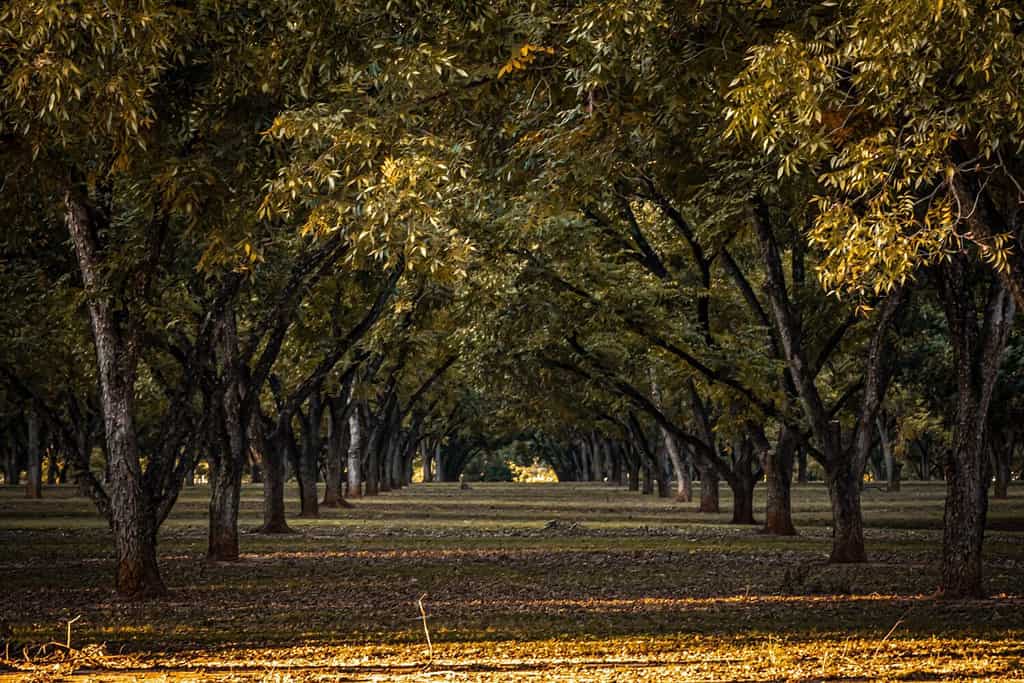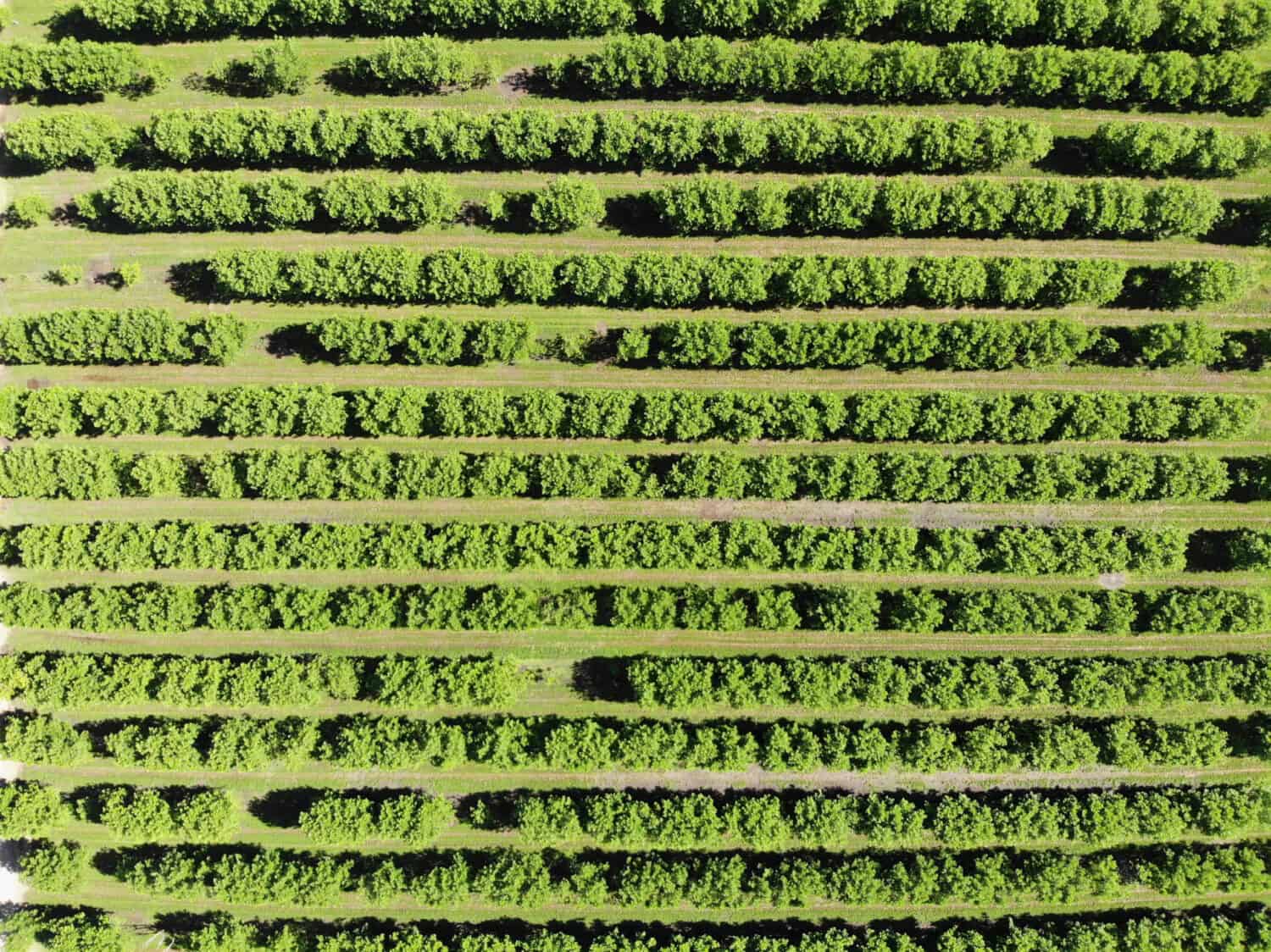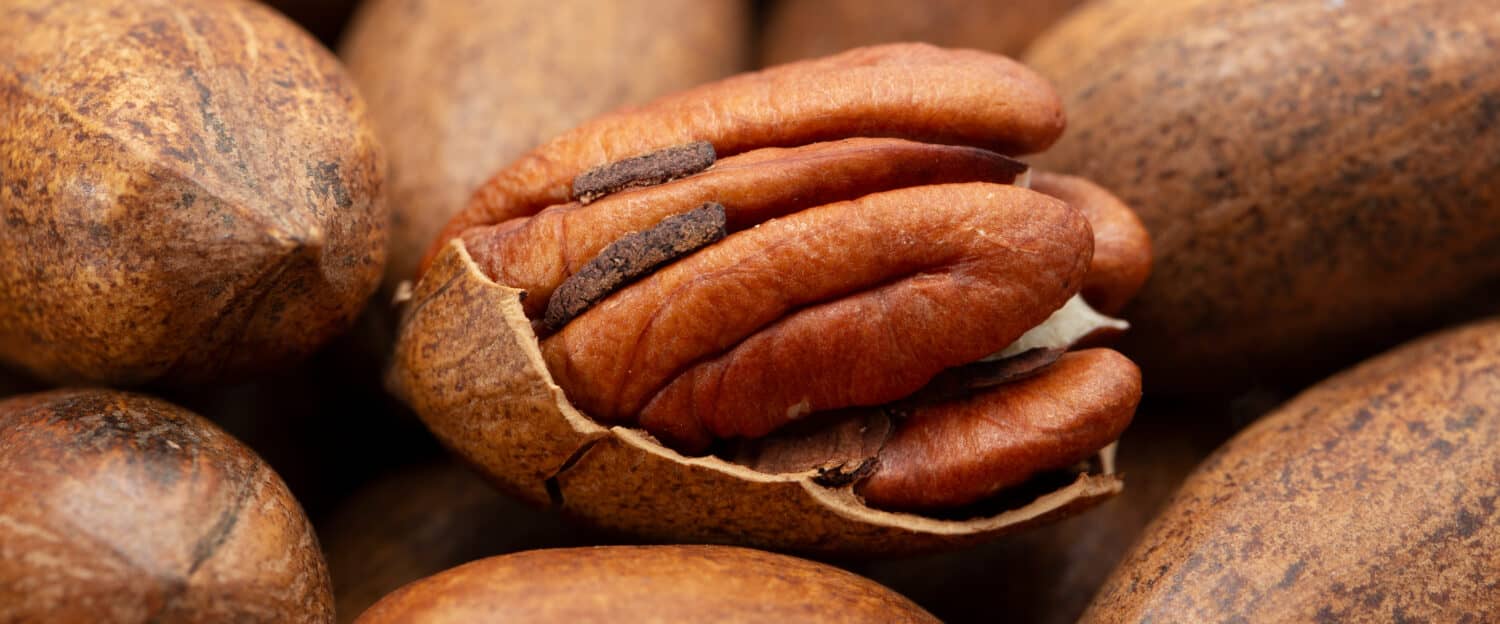Pecans are a staple in many autumn recipes. Pecan pie is likely the most well-known, but pecans also show up in cakes, muffins, pancakes, and countless other sweet treats. These nuts are popular ingredients in salads. There are also savory pecan recipes where the nuts are used in breading, casseroles, and even soup. The nuts are also a delicious and healthy snack on their own. They are rich in antioxidants, fiber, thiamine, copper, manganese, and zinc. But where do these nuts come from? Here’s a look at pecan production in the United States and the five states that grow the most pecans.

U.S. Pecan History
Pecans were originally seen as a novelty in colonial America. Fur traders brought pecans from Illinois to the Atlantic coast. They called them “Illinois nuts,” hence the pecan tree’s scientific name, Carya illinoinensis.
The word “pecan” originated from the Algonquin Indian word “pacane,” which roughly translates to “nut that is cracked with a stone.” Pecans were a staple of the Algonquin diet. Americans, though, would be slower to embrace these tree nuts. Commercial pecan production didn’t begin in the United States until the late nineteenth and early twentieth centuries.

It took a while for Americans to learn the value of growing pecans.
©iStock.com/Skapie777
Today, the U.S. is the world leader in pecan production. The pecan is the only commercially produced tree nut native to the United States. The annual U.S. yield is 250-300 million pounds, accounting for 75-80% of the world’s pecans. The annual pecan harvest in the U.S. is worth around $500 million.
The remaining 20% of the world’s pecan supply largely comes from Australia, Brazil, Israel, Mexico, Peru, and South Africa.
Pecan Trees
The pecan tree is a species of hickory in the walnut (Juglandaceae) family. The tree matures and begins producing nuts by the time it is eight or nine years old. Under the right conditions, a tree can continue to produce pecans for another 200-300 years!
Pecan trees thrive in Zones 6-9 on the USDA’s Plant Hardiness Zone scale, though some growers have had success growing the trees in Zone 5. As a general rule, pecan trees require 200+ frost-free days for the nuts to mature (though this can vary depending on the variety). They also need hot weather to ripen fully. In the United States, this limits high-yield commercial pecan production to the nation’s southerly regions. Here are the top pecan-growing states in the U.S.

The pecan tree is a type of hickory that thrives in the American South.
©Gestalt Imagery/Shutterstock.com
One note as we begin: it is difficult to calculate the annual pecan production of each state because it can vary widely from year to year. Like other fruit and nut trees, pecan trees exhibit what is known as “alternate bearing.” This is a characteristic where a tree produces an abundant crop one year, followed by a significantly smaller harvest the next year. Then, the tree often returns to an abundant yield in the third year. When increases or decreases are noted in the list below, some of the changes can be attributed to the natural alternate bearing of pecan trees.
1. Georgia
While Georgia is known as the Peach State, it could just as accurately be called the Pecan State. Georgia produces more pecans than any other U.S. state.
Georgia farmers didn’t embrace the pecan as a potential cash crop until the late nineteenth century. By 1910, pecan orchards proliferated in southwest Georgia, although most were quite small by today’s standards. In the 1920s, the state was harvesting 2.5 million pounds of pecans annually, and would only continue to rise from there. By the 1950s, Georgia had become the leader in U.S. pecan production, a title it has never relinquished.

Pecan orchards like this one proliferate in southwest Georgia.
©J. Frederick/Shutterstock.com
Today, Georgia produces 110 million pounds of pecans annually, about a third of the total U.S. production. More than 144,000 acres of the state’s land are dedicated to pecan cultivation.
Pecan trees need deep, well-drained soils and copious amounts of sunshine. Georgia has that in spades, especially in the southwest, where the trees thrive in the sandy loam soil with clay subsoil.
The area around Albany in southwestern Georgia produces the most pecans, earning it the title of Pecan Capital of the World. Dougherty and Mitchell counties lead the state in pecan production, though orchards are found throughout the state’s southwestern region. There is a small unincorporated community in Clay County known as Pecan, a nod to southwest Georgia’s prolific pecan production.
The pecan tree is so central to Georgia’s identity that when Atlanta hosted the Summer Olympics in 1996, the handles of the torches that were carried from Athens, Greece, to Atlanta were made of wood from pecan trees.
2. New Mexico
The second spot in U.S. pecan production belongs to the Land of Enchantment. Over 37,700 acres of land in the state are dedicated to pecan growing. New Mexico produces around 90 million pounds of pecans each year.

New Mexico pecan groves such as this one are increasing in size and in number.
©Seanito71/Shutterstock.com
While Georgia still produces more pecans, pecan production in the Peach State is estimated to decline this year (again, remember pecan trees are alternate-bearing plants). National Nut Grower estimates that Georgia’s 2023 production will decline by as much as 12% from 2022. Meanwhile, New Mexico’s pecan production is expected to jump 28.5%. Pecan production is skyrocketing in New Mexico. Even with alternate bearing numbers taken into account, the day could come when New Mexico overtakes Georgia as the nation’s leading pecan producer.
Pecans represent the fourth most valuable agricultural commodity in New Mexico, behind milk, cattle, and hay.
Most of the state’s pecans are grown in the southern portion of the state, with Doña Ana County leading the way. This one county contains approximately 68% of New Mexico’s pecan acreage. Stahmann Farms operates the largest pecan orchard in the world south of Las Cruces in Doña Ana County.
3. Texas
The Lone Star State is the third-largest producer of pecans in the U.S., with an annual harvest of 38 million pounds. Pecans have a long history in Texas. Archaeologists have found fossilized evidence of pecan seeds and leaves along the Rio Grande dating back to 6100 B.C.
The pecan tree is native to more than half the counties in the state. Fittingly, the pecan tree was named the official state tree of Texas in 1919. The pecan has also received other state designations. It was named the official state health nut in 2001. Pecan pie was named the official state pie of Texas in 2013.

Pecan pie is the state pie of Texas.
©MSPhotographic/Shutterstock.com
Orchards of pecan trees thrive in east, central, and south Texas. San Saba in central Texas is the highest pecan producer in the state. In fact, some have declared San Saba the Pecan Capital of the World (though the residents of Albany, Georgia, would strongly disagree).
4. Arizona
Arizona is the fourth-largest pecan producer in the U.S., with an annual yield of 32 million pounds. The state’s production is estimated to decline about six percent from 2022 to 2023.
There are about 26,000 acres of land dedicated to pecan cultivation in Arizona. That number is projected to grow past 30,000 acres in the coming years.

This pecan orchard, as seen from above, is located in southeast Arizona.
©C Bullock/Shutterstock.com
Arizona’s pecan orchards can generally be found along a diagonal line drawn from the northwest to the southeast corners of the state. The biggest pecan-producing counties in the Grand Canyon State include Cochise, Gila, Graham, Greenlee, Maricopa, Mohave, Pima, Pinal, and Yavapai.
5. Oklahoma
The Sooner State is estimated to see a rise of 37.5% in pecan production from 2022 to 2023. The 2023 yield is projected to be 22 million pounds.
Oklahoma designated an official state meal in 1988, becoming the first state to do so. (Louisiana would be the second state to name an official meal, but not until 2015.) The official meal of Oklahoma ends with pecan pie for dessert. The rest of the state meal consists of fried okra, cornbread, barbecue pork, squash, biscuits, sausage and gravy, grits, corn, strawberries (the Oklahoma state fruit), chicken fried steak, and black-eyed peas. That would be quite a feast!

Oklahoma harvests 22 million pounds of pecans each year.
©Piotr Velixar/Shutterstock.com
Pecans are native to Oklahoma and are found in about sixty of Oklahoma’s seventy-seven counties. The only places where pecans do not thrive are the far northwest and Panhandle regions.
Other States
Pecans are commercially grown in ten other states, but the annual yield is sharply lower than the top five pecan-producing states. The states that round out the U.S. pecan production market include:
- Louisiana – eight million pounds
- Florida – seven million pounds
- North Carolina – five million pounds
- Arkansas – four million pounds
- California – three million pounds
- South Carolina – three million pounds
- Alabama – two million pounds
- Mississippi – two million pounds
- Kansas – two million pounds
- Missouri – one million pounds
When Are Pecans Harvested?
We’ve seen where pecans are harvested in the United States, but when are they harvested? The pecan growing season is typically from April to September. The nuts are harvested in October and November, sometimes stretching into early December.
Pecans will naturally fall from the trees once they are ripe. That’s fine if you are collecting a few nuts from a backyard tree to make a Thanksgiving pecan pie, but commercial growers cannot afford to harvest pecans in drips and drabs. Instead of waiting for the pecans to drop on their own, these growers fast-forward the process in a big way! Check out this video from a Texas orchard to see how it’s done.
A mechanical shaker grasps the trunk of a pecan tree and then shakes it hard enough to dislodge the nuts but not so hard that the tree’s roots are damaged. The tree is completely unharmed in the process.
After the nuts rain down from the sky (quite literally), they remain on the ground until another piece of machinery called a picker or a harvester collects them. The pecans are then cleaned, sorted, and bagged.
Pecan Pronunciation
There is vehement disagreement on how to pronounce “pecan.” Well, maybe it’s not actually vehement, but there are differing opinions on how to pronounce the name of this native United States tree nut. Is it pronounced “puh-KAHN,” with the emphasis on the second syllable? Or is it “PEE-can,” with the first syllable emphasized? The answer is…yes.
Either pronunciation is acceptable in American English, so let’s turn the debate away from how to pronounce the word and toward who has the best pecan pie recipe. Answering that question sounds a lot more fun (and more delicious)!
Summary of the Top 5 U.S. States That Grow the Most Pecans
| Rank | State | Amount of Pecans Produced Annually | Acreage Dedicated to Pecan Production |
|---|---|---|---|
| 1. | Georgia | 110 million pounds | 144,000 acres |
| 2. | New Mexico | 90 million pounds | 47,000 acres |
| 3. | Texas | 60 million pounds | 125,000 acres |
| 4. | Arizona | 32 million pounds | 26,000 acres |
| 5. | Oklahoma | 22 million pounds | 96,000 acres |
The photo featured at the top of this post is © matin/Shutterstock.com
Thank you for reading! Have some feedback for us? Contact the AZ Animals editorial team.






